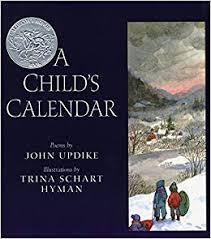Poetry and Pictures for the Year
Listen to the Recess! Clip
| Author | John Cech |
| Air Date | 01/02/2001 |

Poetry and Pictures for the Year Transcript
There are all kinds of ways to help us mark the passage of a year’s time, some concrete or numerical, others imaginative and personal. One of the honor books from last year’s Caldecott awards, is a collection of poems by the well-known writer, John Updike, called A Child’s Calendar. These are simple, elegant verses that call up a month’s experience in a few haiku-like images. Here’s the opening from January:
The days are short, The sun a spark, Hung thin between, The dark and dark.
April is bursting with Wordsworthian energy: “The sky’s a herd of prancing sheep, The birds and fields abandon sleep, and jonquils, tulips, daffodils — bloom bright upon the wide-eyed hills.” And September has an achingly wistful quality: “The breezes taste of apple peel. The air is full of smells to feel — Ripe fruit, old footballs, drying grass, new books and blackboard chalk in class.”
Add to these tender poems Trina Schart Hyman’s beautiful illustrations of family picnics and kids cutting out valentines, garden-planting, leaf jumping, and quiet winter walks — and you have a dazzling book, that is both archetypal-ly New England and purely American.
And if you’d like to journey even further back into this country’s mythic agrarian calendar, try The Year With Grandma Moses, with a text for young people by W. Nikola-Lisa to accompany the luminous paintings and remembrances of the famed, so-called “primitive” artist, Anna Mary Moses. She and her husband, Thomas, were hard-working tenant farmers who eventually got their own place, settled in, and raised their family. Between the myriad chores and the many demands on her time, she somehow managed to keep up with her “fancy work” — the small, delicate, child-like paintings of farm life that she produced throughout the 1920s and 30s and which were being exhibited in a local drugstore window when they were discovered, quite by accident, by a visiting New York art collector in 1938. Grandma Moses was in her late seventies at that time, but she went on painting until she was over a hundred year old and her pictures — of a lush, tranquil valley seen through the gauzy white puffs of a lace curtain, or of children climbing in trees or playing pranks on Halloween, of sleigh rides and apple harvests and maple sugaring — had become part of the landscape of our national imagination, and part of the way we measure the true, deep pulse of time.